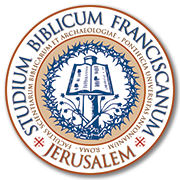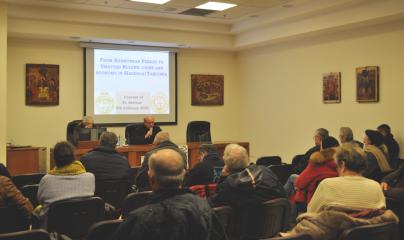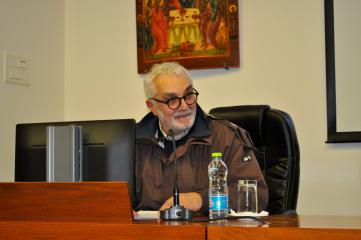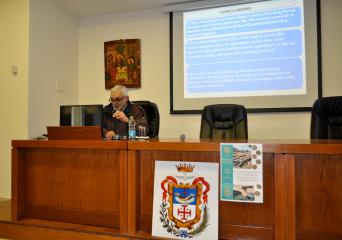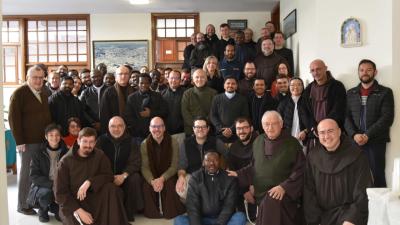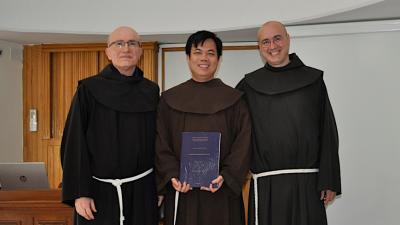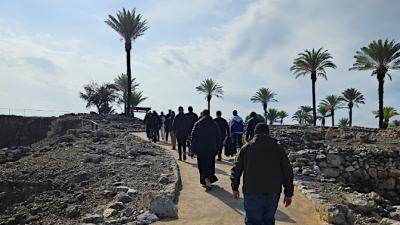
Thursday 9th of February 2023 in the St. Francis Hall, at St. Saviour’s Monastery, Prof. Bruno Callegher held the lecture:
From Hasmonean Period to Umayyad Rulers: Coins and Economy in Magdala/Tarichea.
Bruno Callegher is professor of Numismatics at Università degli Studi di Trieste (Italy) and member of the scientific committee of the SBF Museum.
A summary of the speech by Prof. Callegher follows.
—
From Hasmonean Period to Umayyad Rulers: Coins and Economy in Magdala/Tarichea It was thanks to the study of the numismatic documentation of Capernaum, conducted prior to the start of the excavation campaigns of the Studium Biblicum Franciscanum Custody of the Holy Land, that similar research was extended to the monetary findings from the nearby site of Magdala. Here, in fact, the archaeologists of the SBF from the 1970s until 2013 carried out various excavation campaigns aimed at discovering the real extent of the archaeological remains, but also (and perhaps above all) the relationship between archaeological evidence and the written sources that had preserved records of Magdala. The task of studying this numismatic dossier was given to me by Giovanni Claudio Bottini, formal Dean of the SBF. At that time, the numismatic documentation only referred to the area investigated on the property of the Custody of the Holy Land. The first excavations, dated at least to 1970/71, took place in the stretch between a monastery of Byzantine layout, some Roman-era roadways, several buildings with different functions or chronology, and finally the lake port.
The long history of this work places, has Stanislao Loffreda at its beginning: I am grateful to him for the trust he placed in me during our conversations in his archaeological laboratory at the SBF, which were always rich in information and open to scientific discussion. The entire SBF community welcomed me with warmth and cooperation during the study weeks that followed, albeit irregularly, between 2008 and 2015 as well as in the summer of 2022. Among them, Eugenio Alliata, the Deans Giovanni Claudio Bottini, Massimo Pazzini, and now Rosario Pierri. To these, must be added those involved in the MP, in particular Stefano De Luca and the archaeological team of the SBF.
And, back to the site and its history…., from 1991–1992, the Israel Antiquities Authority initiated a number of archaeological excavations to the west and south of the area considered here. Additional investigations by the IAA followed in 2002. Shortly afterwards, an economic-religious development project called Magdala Centre led to the discovery of a probable synagogue from the first century CE and one of the oldest a menorah image, prompting —from 2005— the exploration of the site that took on the dimension of a large-scale systematic urban excavation. The considerable historical-documentary significance of these discoveries caused the archaeological excavations to be extended as far as possible in order to define the extent of the settlement and its function in relation to other historical sites on the shore of Lake Kinneret. Other emergency excavations, undertaken between 2009 and 2013 in collaboration with the Universidad Anáhuac México Sur and the Universidad Nacional Autónoma de México, were motivated by the construction of tourist hotel facilities. All this took place around the area that had been acquired by the Custody of the Holy Land in 1935. As a result, the SBF was in tune with the renewed interest with the Corbo-Loffreda excavations in the 1970s and the recent Magdala Project.
If, for the plots owned by the Custody of the Holy Land, Stanislao Loffreda's generous and profound archaeological expertise made it possible to unify the numismatic data from the 1970s excavations with those collected during the MP's long activity, the same was not possible with the same numismatic data from excavations in the surrounding areas and, generally, from the site included in the MAP.
******
It is well known that, coins are archaeological finds potentially rich in information because they combine chronological, epigraphic, iconographic and, most importantly, economic data.
Monetary finds can, therefore, contribute to our knowledge of ancient societies, especially through the reconstruction of the volume of coinage and its circulation away from or close to the place of actual coin production, but only if placed correctly in their general historical context. However, the minted stock, which can also be described by observing the different monetary types and the choice of metals to be minted, is closely linked to its circulation: money was minted, hence money was provided if there was demand, i.e., demand for money/supply of money. With reference to the region in which Magdala was located, it is barely necessary to mention the radical difference between the epochs of the Seleucids, the Ptolemies, the Hasmoneans, the progressive Romanisation up to full Roman imperial contròl, and finally the crisis of the Roman empire, the Byzantine and then Umayyad authorities. Denominations changed; at times silver struck with large and small divisionals was favoured, at other times bronze prevailed. The units of account and the physical pieces (coins) that represented them in whole or in part, therefore varied.
Once in circulation, the coin passed from hand to hand, and on leaving its area —i.e. where pre-established values and exchange ratios were in force—it had to be confronted with a divisional responding to different values both in terms of weight and fineness, and therefore face value.
And, by the way, what about trade, or rather, the allocation of artefacts and agrarian product not so much according to the law of supply and demand, but of the availability of a good at that time according to the climatic seasons and the specificities of a given region? The “trade” could take on an irregular, periodic character and in any case be dictated by the needs of a single community. Perhaps more structured were the economic aspects of taxation or the procurement of resources for the administrative bureaucracy and especially for army logistics. In other words, trade and “economy” in the ancient world are not even remotely comparable to our semantics.
And another suggestion as well: for a long time, the locality of Magdala was thought of as the village of the evangelical Mary of Magdala, an approach reinforced by the image that Galilee had been a separate rural region full of farming villages. In this regard, for an analysis of the cultural tradition concerning the 'concept' of Galilee over the centuries up to most recent times, one should consider the questions concerning Galilee from the chronology of settlements, including the interpretation of archaeological finds, to the dynamic relations with neighbouring territories, the presence of different cultural and religious elements, the influence of Tyre and the Hellenistic cities of the Decapolis to the settlements along Lake Kinneret, within the peculiar geographic framework of this territory: the largest freshwater reservoir is a hinge area with easy communications in all directions, towards the Mediterranean and inland between Syria and the Red Sea along the Jordan Valley. In fact, Magdala, therefore, cannot be dìvorced from its regional context. For this reason, numismatic evidence is of great value as it helps to establish the period when the site was first frequented, the interconnections with the cities on the coast, Tyre in primis, but also with the places of trade over the short distance, locally, along the shores of the lake, the true epicentre and in fact the fastest route of communication/transport. Numismatic evidence can also help clarify contacts over the long distance, with Judea and Samaria, but also with Phoenicia and Coele Syria, Hauran and the Jordan regions towards the Red Sea.
On the basis of the numismatic evidence analysed and of what was possible to compare thanks to the shared numismatic data emerging from the MAP excavations at Magdala, here the periodisation with the Wadi Hamam site as well.
The coins found at Magdala in the area investigated by the SBF (excavations 1970/1971–2013) are 2613 to which are added 12 fragments of almost certainly coins, and 2 exagia, bringing the total to 2627 items. Of the 2613, only 1566 have been identified or attributed to a chronological period on the basis of a complete reading or the identification of a relevant iconographic element. A very high proportion, 1047 coins, are in such a bad state of preservation (limestone, corrosion, mineralisation of the flan) that it is impossible to classify them without working on the basis of imagination and without subjecting oneself to the uncertainty of the time of a possible restoration (40% of the specimens), which is also very costly. In fact, for only 60%, so just over half, was a complete or partial classification possible, and in any case reliable. The numismatic material also included two hoards: one from the Roman imperial period found in H, Field 3-US 8 (21 Roman provincial coins) and one from the Arab-Byzantine period in E 11 (9 coins), which will both be described separately.
A substantial continuity of coin presence emerges from Alexander Janneus until the end of the fourth century, after which the circulating (Byzantine, Arab and Crusader) coinage declines significantly. There are, of course, some variations in the presence of an authority (e.g. Alexander Janneus) or an emperor (e.g. Trajan or Elagabalus), as well as in the mints of origin (e.g. Tyre, Jerusalem, Tiberias, etc.).
In this monetary documentation, I shall focus on two such cases:
1. Alexander Janneus and Hasmonean Period. In the area excavated by the MP, the quantity of Hasmonean coins, almost exclusively of Alexander Jannaeus, is truly remarkable and accounts for the overall percentage of ca. 20.5% of all identified coins. However, it is highly probable that in the large number of specimens deemed unclassifiable due to their poor state of preservation, a considerable number could be placed in this chronological period. Magdala, perhaps even then a port on the lake, must have been involved in the logistical needs arising from the presence and frequent movement of military contìngents to, most probably, the settlement of people looking for land. Moreover, the spread of prutot of the most important of the Hasmoneans is ubiquitous in much of Palestine, moreover in quantities that are always very conspicuous, often in the order of magnitude of many hundreds of specimens and, in statistical terms, often with a far greater percentage than other slightly earlier or later coinages.
2. During the 3rd century, the supply of bronze coinage was provided, with quantitative differences, by cities in the provinces of Phoenicia and Syria, Galilee and Samaria, Decapolis and Arabia. Other mints like Capitolias, Esbous, Nysa-Scythopolis, the distant Petra and Pella to the south-east and Philippopolis in the Jebael Hauran to the north-east are attested in Magdala with a few specimens that can be traced back to bronze circulation on a fiduciary basis. It is well known that countermarks were applied to the roundels of almost always worn or fairly worn coins in order to give a higher or lower price than the circulating coin with a different weight and sometimes with a different fineness. In each case the countermark turned the old coin into a new issue, although countermarks with explicit reference to a value/quote are quite rare. The phenomenon has been known since the Hellenistic period, but became very common among provincial Roman coins from the late second century onwards and intensified in the Severan period. It is still not clear, however, whether the application of a punch with the image of a deity, emperor or other symbol revalued or adjusted downwards that specific coin because the starting price is unknown. Countermarking meant establishing a new relationship with the newly minted coin, officially issued by the local authority. It can be deduced that the use of countermarking was intended to bring some order into a circulating currency that could escape the control of a city's authority. Which raises other important questions: who decided and controlled the application of countermarks and for what monetary purpose? Because it is not even conceivable, in a field so relevant to the determination of monetary values, that the application of punches/countermarks was beyond the control of at least some authority. But beyond general considerations of the countermark phenomenon, in and around Magdala the most striking fact is the number of attestations, making this sample the most conspicuous known so far from the whole of Galilee. The common element, in the vast majority of cases, seems to be the application of an elliptical countermark with a male head (of an emperor or a deity, often indistinguishable), as if in this area it had been necessary to put in order the quotations of various assaria brought by mercatores or, more probably, milites following movements along the limes arabicus and who might have chosen Magdala because of its favourable position on the lake and a certain ease of supply.
What historical-economic information, in this albeit synthetic framework of sources, do the monetary finds offer us? Let us try to indicate them briefly.
1. The amount of coinage is so abundant in at least three phases (Hasmonean, Herodian and Severian) that accidental losses must be ruled out, identifying them instead as a consequence of an intense exchange of goods versus currency.
2. The value of the recovered currency is almost always modest, often very modest.
3. It is possible to place the surplus of the small-denomination divisional in certain market occasions or periodic fairs, while for accounting (recording debits and credits) a good, stable silver coin was used: the Tyrian tetradrachm.
4. The coins come from various mints such as Tyre between the first century BCE and the second century CE; from Jerusalem in the Hasmonean period; from nearby Caesarea Panias, Tiberias and Sepphoris in the Herodian period; from the mints of the Decapolis and Galilee between the mid-second –mid-third century. From this we deduce that circulation was ensured by the nearest monetary workshops, probably because the quotation of assaria was common in those mints and also accepted in Magdala.
5. The contribution of more distant mints, including Rome, remains very limited and from the fourth century onwards it was the coins of Antioch and then Constatinopolis that reached Magdala.
6. Some archaeological finds, in part definable as paramonetary (Tyre ambit weights; fourth–fifth century exagrams, tiles with agoranomoi names) allow us to deduce, rather than hypothesise, the operation of a market in some square/space of the site, where the coinage, with a certain continuity, was used with a liberating function.
7. It is more than conceivable that the mercantile function, evidenced by the large quantity of coinage, is to be linked to the presence of military contingents with stable or temporary settlement in the area of Magdala, as can be deduced from the Latin and rabbinic sources concerning this site.
On a monetary basis, therefore, Magdala must be considered one of the most important and active settlements between the first century BCE and much of the third century CE on Lake Kinneret, a place of production and trade, supplier to military contingents, certainly in contact with other trading places probably located on the Mediterranean coast, however in a 'market' perspective quite different from our current experience and even from the semantic content of this word that does not correspond to the experience of the ancients. Its monetary decline began as early as the early fourth century, when the economic and monetary strategies of the Constantinian era shifted the flow of money to other routes, especially between the great port cities of the Mediterranean.
